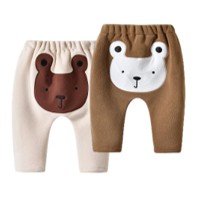Baby Pants Size Chart
| Size | Age | Height (inches) | Weight (pounds) | Waist (inches) |
|---|---|---|---|---|
| Up to 7 pounds | Up to 7 pounds | Up to 20.5 | Up to 7 | 16.125 |
| 0 to 3 M | 0 to 3 months | 20.5 to 24 | 7 to 14 | 16.125 to 17.375 |
| 3 to 6 M | 3 to 6 months | 24 to 27 | 14 to 18 | 17.375 to 18.5 |
| 6 to 9 M | 6 to 9 months | 27 to 29 | 18 to 22 | 18.5 to 19 |
| 9 to 12 M | 9 to 12 months | 29 to 30.5 | 22 to 26 | 19 to 19.5 |
| 12 to 18 M | 0 to 3 months | 30.5 to 21 | 26 to 28 | 19.5 to 20.25 |
| 18 to 24 M | 18 to 24 months | 32 to 33.5 | 28 to 30 | 20.25 to 20.5 |
| Baby Pants Size Chart Maker : iSizeChart.com | ||||
About Baby Pants Size Guide Chart
What kind of pants are beneficial for baby health?
When choosing pants for babies, prioritizing comfort, safety, and health is essential. Here are some key features to look for in baby pants to support their well-being:
1. Soft, Breathable Fabrics.
Avoid synthetic materials (like polyester) that may trap moisture and cause irritation.
2. Comfortable Fit.
Loose cuts allow free movement for crawling and kicking, avoiding tightness around hips or legs.
3. Easy Diaper Changes.
Avoid complicated zippers or hard buttons that could pinch the skin.
4. Seasonal Adaptability.
Winter: Choose fleece-lined or thermal pants (ensure they’re not too bulky under outerwear).
5. Safety Features.
Flame-resistant fabrics (for sleepwear) if required for safety standards.
6. Non-Toxic Dyes.
7. Footless Designs.
8. Durability.
Avoid: Tight jeans or stiff fabrics that limit movement. Overly baggy pants that could trip the baby.
Pro Tip:
Layering is key! Pair breathable pants with a onesie or lightweight top for easy adjustment to temperature changes.
By prioritizing these factors, you’ll support your baby’s comfort, skin health, and physical development. Always check for irritation signs and adjust clothing choices as needed.
